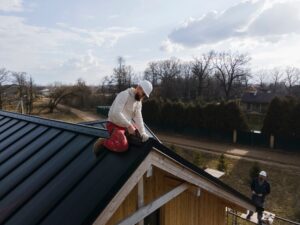You wouldn’t leave home on a cold and rainy day wearing an old tattered rain jacket full of holes and rips, would you? Just as a good raincoat protects your body from the elements, quality siding does the same for your home and everything in it.
As your home’s siding never takes a day off, it is inevitable that every homeowner will experience at least some of these common problems, if not all. And with constant exposure to the sun, rain, snow, falling tree limbs, active children, and the ever eroding sands of time, you probably have experienced some of these common siding problems at your home already.
So read on to learn more about these common issues, how to prevent them, and what to do if they’ve already happened:
- Cracks and Damage
Whether it’s a small crack caused by a singular impact or an entire panel that has been ripped off in a storm, all siding materials are susceptible to this type of damage. Hail, falling tree limbs, rocks, sports balls, and other projectiles all pose a threat to the integrity of your home’s siding.
Hail can cause extensive damage to the home, affecting the windows, gutters, and roof, along with your siding.
Even though it is overall very durable, vinyl siding is perhaps the most vulnerable to punctures as the material is quite thin and is not backed firmly against the side of your house. Fortunately, vinyl siding is easy to replace and repair.
For smaller cracks and holes, you may only need to employ the use of a patch kit. Follow the instructions on your patch kit to seal the hole. In order to create a seamless patch job that is hardly noticeable to the naked eye, the patch will have to be paint matched to the color of your siding.
- Replacing Damaged Vinyl Siding
Replacing an entire panel of siding is easier than you might think. Most panels come in easy to manage strips that interlock with the panels above and below it. Maybe this is why vinyl siding continues to account for the largest share of the siding market.
To replace your damaged vinyl panel, find the end of the panel above it and pull it away from the house. It should pop out with a little work. Now run your hand along the underside of the panel separating it from the damaged panel – this will expose the nail strip of your damaged panel. Remove the nails from your damaged panel and discard it.
With your panel removed, you are ready to insert your replacement piece by sliding it up and clipping it onto the nail strip of the panel below. Make sure it is overlapped with the panels on either side of it, as vinyl siding will expand and contract side to side with the change in temperatures.
Nail your siding on, but not firmly against the side of your house; you want it hung so that it has a little wiggle room.
- Color Fading and Peeling Paint
There’s nothing quite like pulling into your driveway at the end of a long day and seeing a beautiful home in front of you. As your siding starts to fade and peel over the years, your home’s appearance and the feeling you get when you arrive there become lackluster.
Not only will this reduce the pride you take in your home’s appearance, but it can drastically reduce your home’s curb appeal, and therefore its value. And if you plan on selling your home any time soon, know that an exterior paint job can lead to a 55% ROI.
Even if you’re not planning on selling, performing regular siding maintenance such as cleaning and painting the exterior of your home should extend the life of your siding and help keep its luster.
But if your house has already faded from the sun’s UV rays and you’re starting to see paint chips in the yard around your foundation, it’s definitely time for a paint job. Peeling paint will leave your bare siding exposed to the elements, and allow moisture to creep in and cause damage that cannot be fixed with a paintbrush.
In the process of painting, all peeling paint will be scraped away and a new coat of paint will be applied. A fresh coat of paint will not only eliminate all signs of fading but will also seal it, therefore weatherproofing your siding.
- Noisy Siding Keeping You up at Night?
If you are hearing creaks, pops, and rattles in the night, you can stop worrying about ghosts because it is most likely your siding. Who knew siding could be so loud and active?
Excessively noisy vinyl siding is usually caused by an improper installation job. Vinyl siding is hung against the side of the house in a way that leaves room for contraction and expansion as the temperature fluctuates from cold to hot over the course of each day, and the seasons.
If your siding is nailed tightly to the house, you will hear cracks and pops as your siding fights to expand. Rattles are commonly heard when a strong wind blows against siding that has been hung too loose.
Using a professional contractor who specializes in siding installation is a surefire way to avoid this common problem.
- Buckling and Warping
Buckling and warping of your siding is another issue that results from improper installation. Again, vinyl siding needs to be hung to allow room to expand and contract, as changes in temperature cause it to do so. If your siding is nailed down too tight and expands with nowhere to go, buckling and warping are the results.
Prevent this from the outset by hiring experienced licensed professionals to hang your siding.
- Siding Problems Caused by Pests
Wood siding is a particularly comfortable home and a food source for many insects and other critters including carpenter ants, termites, carpenter bees, and powder post beetles. A lot of this damage happens inside the boards and is not visible from the exterior, making it hard to spot.
Of course, all of this insect activity has to attract some attention, and that’s usually in the form of the woodpecker. Woodpeckers don’t care about the integrity of your siding. In fact, they actively destroy it in the process of extracting a few tasty morsels in the form of ants and larvae.
The best way to combat these unwanted dinner guests is through insecticides that no longer make your wood siding an all you can eat buffet. Eliminate the bugs, and the woodpeckers go with it.
If your home is infiltrated by mice or chipmunks, it’s best to have a professional inspection done to help find and seal the access points.
- Damage From Moisture
Moisture is an enemy of your home’s outer walls, which is why we use siding to protect it. If you see signs of damage caused by moisture such as soft rotten boards on wood siding, it is best to address this issue immediately.
If your siding is compromised by moisture, the damage can easily extend to your home’s walls and frame. Chances are if you have multiple leaks throughout your home caused by moisture damage to your siding, its too late for a small repair job. Extensive work is usually necessary and replacing the siding around your entire house may be in order.
Moisture damage can be repaired by removing the rotted area and replacing it with a new board. Regular siding maintenance, yearly inspections, and proper drainage from your roof will all aide in preventing moisture damage to your siding.
- Poor Energy Efficiency
Many siding problems such as physical damage and fading are obvious. But poor energy efficiency likes to sneak under the radar. How do you tell if your siding has an issue with energy efficiency? The only way is to monitor your utility bill month to month and keep your eye out for any inexplicable rises in cost, especially in the winter.
So how do you fix this invisible problem that is very common amongst homes with older siding? The solution lies not only in the siding you have, but the insulation behind it. To keep your home cooler in the summer and warmer in the winter, talk to contractors in your area about the perfect insulated siding solution for your home.
Say Goodbye to Siding Problems
If you’re experiencing any of these common siding problems, know you’re not alone. Maintaining your siding is an essential part of home maintenance and is something every homeowner has to face.
Proper siding maintenance can be a big job. Luckily, we are here to help! Contact us today to learn how we can help you maintain the integrity and appearance of your home.









